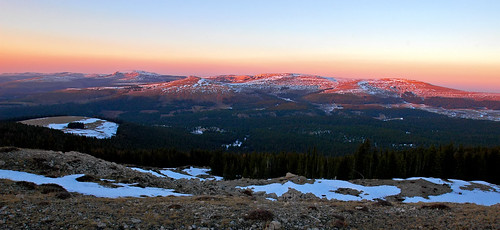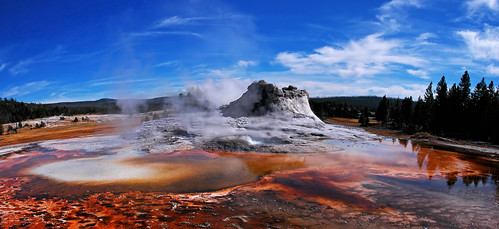It's a must to view these large (click images), or if you dare go for the giant-sized originals hot-linked under each photo (3-4 mbs/ea-dial-up warning).
Sundown at the Medicine Wheel

Original Size
Castle Geyser Surreal

Original Size
The Top Photograph is from the Bighorn Mountains in Wyoming, a place I hope to explore quite a bit more someday in the near future. We were attempting to visit the Medicine Wheel and were stopped on the account of deep drifting snow and light.
The Medicine Wheel is an important place to many peoples. From the Stanford Solar Center:
On top of the Bighorn Range in Wyoming, a desolate 9,642 feet high and only reachable during the warm summer months, lies an ancient Native American construction -- an 80' diameter wheel-like pattern made of stones. At the center of the circle is a doughnut-shaped pile of stones, a cairn, connected to the rim by 28 spoke-like lines of stones. Six more stone cairns are arranged around the circle, most large enough to hold a sitting human. The central cairn is about 12 feet in diameter and 2' high.
If you stand or sit at one cairn looking towards another, you will be pointed to certain places on the distant horizon. These points indicate where the Sun rises or sets on summer solstice and where certain important stars rise heliacally, that is, first rise at dawn after being behind the Sun. The dawn stars helped foretell when the Sun ceremonial days would be coming. The area is free of snow only for 2 months -- around the summer solstice.
The wheel has 28 spokes, the same number used in the roofs of ceremonial buildings such as the Lakota Sundance lodge. These always includes an entrance to the east, facing the rising Sun, and include 28 rafters for the 28 days in the lunar cycle. The number 28 is sacred to some of the Indian tribes because of its significance as the lunar month. In Bighorn's case, could the special number 28 also refer to the helicial or dawn rising of Rigel 28 days past the Solstice, and Sirius another 28 past that?
Still interested in learning more? Keep reading this article here.
The Bottom Photograph features Castle Geyser, which has some of the most impressive sinter deposits in the world. For more info on this impressive formation from Wikipedia:
The geyser has a 10-12 hour eruption cycle. The geyser erupts hot water for about 20 minutes to a height of 90 feet (27 meters) before changing to a noisy steam phase for 30-40 minutes.
It is also noted for the particularly large sinter deposits that form its cone. These have been likened in appearance to a castle. This appearance led Lieutenant G.C. Doane to name it Castle Geyser in 1870. The geyser is located in the Upper Geyser Basin a short walk from Old Faithful Geyser.
The sinter cone for Castle Geyser was dated to around 1022 using carbon-14 dating. This date is much younger than the presumed age of 5000 to 15000 years. A 3-D laser scan done of the cone shows evidence that this geyser has gone through four to five distinct stages to reach its current configuration.


1 comment:
That geyser looks scary dangerous! Looks like something from another planet. Care for a swim? Nice shots, thanks for posting them.
Post a Comment